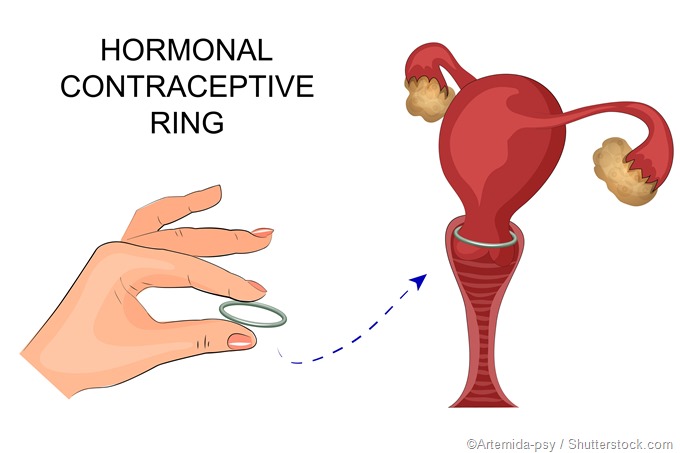Oral contraception is a very popular means of contraception with a very high efficacy. However, it is necessary to be fully compliant with the regime to reap its full contraceptive benefits.
Since most users register a significant rate of poor compliance, the pregnancy rate is higher than expected. This was one reason behind the development of the vaginal contraceptive ring.

The vaginal ring is a reversible means of hormonal contraception which offers significant benefits in the form of more convenient dosing. This pushes up patient compliance, which in turn means the effectiveness is much higher. In fact, it is almost 100 percent effective when used correctly.
Advantages
The vaginal ring releases 15 mcg of ethinyl estradiol and 120 mcg of etonogestrel daily for 21 days. This is lower than the dose of estrogen released by the contraceptive pill or patch, resulting in fewer side effects due to estrogen.
- The ring is made of ethylene vinyl acetate copolymer, at its core, into which the hormones are integrated. This means that damage of the ring will not cause higher levels of hormone release
- It is convenient to use because it only requires the user to change it once a month
- It is a good alternative to contraceptive implants or intrauterine devices
- Use of the ring is associated with a lower risk of intermenstrual or irregular bleeding
- It works well even if the woman has gastrointestinal upsets whereas the pill fails to work properly in such situations
- Dysmenorrhea and menorrhagia are improved
- Women using the ring are less likely to be anemic due to iron deficiency, and those with anemia show improvement
- Ovarian cancer and endometrial cancer risks are lowered, as well as the risk of benign breast disease
- The risk of functional ovarian cysts is reduced
- The occurrence of ectopic pregnancy is lower
Minor adverse effects
The use of the ring is associated with some minor side effects, such as:
- Inter-menstrual spotting, very light menstrual spotting, or amenorrhea
- Mild mood fluctuations
- Feelings of tiredness
- A few women may note exacerbation of acne
- Mild breast tenderness
Major adverse effects
Serious side effects of the contraceptive ring include:
- Hypertension may develop in some women
- Irregular bleeding or spotting in more than one cycle
- Severe headaches
- Vomiting and loss of appetite
- Significant increase in body weight
- Breast enlargement and discharge, or severe breast tenderness
- Hirsutism especially on the face
- Feelings of anxiety
Very severe side effects
- Thromboembolic events such as calf vein thrombosis, myocardial infarction, pulmonary embolism, cerebrovascular accidents, or retinal vessel thrombosis
- Severe headaches and migraines
- Hepatitis and hepatic adenomas, which may rupture and cause serious internal hemorrhage
- Major depression
- Increased risk of breast or liver cancer
Disadvantages other than adverse effects
Apart from the side effects, the ring also has some specific disadvantages:
- Provides no protection against sexually transmitted infections (STIs)
- Must be prescribed by a healthcare provider
Contraindications
The vaginal ring is not suitable for the women with the following conditions because of the higher risk for thromboembolism:
- Severe obesity
- History of thromboembolic episodes
- Family history of such conditions
- History of breast cancer, hepatitis, irregular vaginal bleeding, or migraines of certain types
- Exclusive breastfeeding with an infant less than six months old
- Smoking, especially 15 or more cigarettes a day
- Over 35 years of age
- Women on certain medications such as St. John’s Wort, rifampin, or corticosteroids
References
- https://medlineplus.gov/druginfo/meds/a604032.html
- https://www.betterhealth.vic.gov.au/health/healthyliving/contraception-vaginal-ring
- http://phpa.dhmh.maryland.gov/mch/Documents/Family_Planning_Guidelines/1.13,Contraception,VaginalContraceptiveRing,Final,2012.pdf
- http://www.nhs.uk/Conditions/contraception-guide/Pages/vaginal-ring.aspx
- https://www.hhs.gov/opa/pregnancy-prevention/hormonal-methods/vaginal-ring/index.html
Further Reading
- All Contraception Content
- Advantages and Disadvantages of the Contraceptive Patch
- Advantages and Disadvantages of the Contraceptive Implant
- Do Contraceptive Injections Affect Bones?
- How Does the Progestogen-only Pill Work?
Last Updated: Feb 26, 2019

Written by
Dr. Liji Thomas
Dr. Liji Thomas is an OB-GYN, who graduated from the Government Medical College, University of Calicut, Kerala, in 2001. Liji practiced as a full-time consultant in obstetrics/gynecology in a private hospital for a few years following her graduation. She has counseled hundreds of patients facing issues from pregnancy-related problems and infertility, and has been in charge of over 2,000 deliveries, striving always to achieve a normal delivery rather than operative.
Source: Read Full Article
